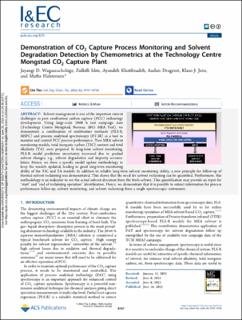| dc.contributor.author | Wagaarachchige, Jayangi Dinesha | |
| dc.contributor.author | Idris, Zulkifli | |
| dc.contributor.author | Khatibzadeh, Ayandeh | |
| dc.contributor.author | Drageset, Audun | |
| dc.contributor.author | Jens, Klaus-Joachim | |
| dc.contributor.author | Halstensen, Maths | |
| dc.date.accessioned | 2024-04-09T11:38:43Z | |
| dc.date.available | 2024-04-09T11:38:43Z | |
| dc.date.created | 2023-09-04T10:41:49Z | |
| dc.date.issued | 2023 | |
| dc.identifier.citation | Wagaarachchige, J. D., Idris, Z., Khatibzadeh, A., Drageset, A., Jens, K.-J., & Halstensen, M. (2023). Demonstration of CO2 Capture Process Monitoring and Solvent Degradation Detection by Chemometrics at the Technology Centre Mongstad CO2 Capture Plant. Industrial & Engineering Chemistry Research, 62(25), 9747-9754. | en_US |
| dc.identifier.issn | 0888-5885 | |
| dc.identifier.uri | https://hdl.handle.net/11250/3125514 | |
| dc.description.abstract | Solvent management is one of the important current challenges in post combustion carbon capture (PCC) technology development. Using large-scale 1960 h test campaign data (Technology Centre Mongstad, Norway, 2015 MEA Test), we demonstrate a combination of multivariate methods (PLS-R, MSPC) and process analytical spectroscopy (FT-IR) as a tool to monitor and control PCC process performance. Two MEA solvent monitoring models, total inorganic carbon (TIC) content and total alkalinity (TA), were prepared. In long-term solvent monitoring, PLS-R model prediction uncertainty increased due to gradual solvent changes, e.g., solvent degradation and impurity accumulation. Hence, we show a specific model update methodology to keep the models updated, leading to good long-term monitoring ability of the TIC and TA models. In addition to reliable long-term solvent monitoring ability, a new principle for follow-up of thermal solvent reclaiming was demonstrated. This shows that the need for solvent reclaiming can be quantified. Furthermore, this methodology is an indicator to see the actual solvent deviation from the fresh solvent. This quantification may provide an input for “start” and “end of reclaiming operation” identification. Hence, we demonstrate that it is possible to extract information for process performance follow-up, solvent monitoring, and solvent reclaiming from a single spectroscopic instrument. | en_US |
| dc.language.iso | eng | en_US |
| dc.publisher | American Chemical Society | en_US |
| dc.rights | Navngivelse 4.0 Internasjonal | * |
| dc.rights.uri | http://creativecommons.org/licenses/by/4.0/deed.no | * |
| dc.title | Demonstration of CO2 Capture Process Monitoring and Solvent Degradation Detection by Chemometrics at the Technology Centre Mongstad CO2 Capture Plant | en_US |
| dc.type | Peer reviewed | en_US |
| dc.type | Journal article | en_US |
| dc.description.version | publishedVersion | en_US |
| dc.rights.holder | © 2023 The Authors. | en_US |
| dc.source.pagenumber | 9747-9754 | en_US |
| dc.source.volume | 62 | en_US |
| dc.source.journal | Industrial & Engineering Chemistry Research | en_US |
| dc.source.issue | 25 | en_US |
| dc.identifier.doi | https://doi.org/10.1021/acs.iecr.3c00134 | |
| dc.identifier.cristin | 2172009 | |
| cristin.ispublished | true | |
| cristin.fulltext | original | |
| cristin.qualitycode | 2 | |

